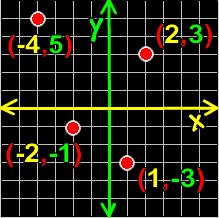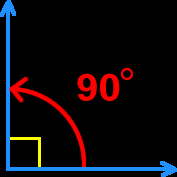Rational Number
A rational number is a number that can be written as a fraction with integers as the numerator and denominator. This includes fractions, regular counting numbers, negative numbers, terminating decimals and repeating decimals.
 |
|

|
|
Rationalize the Denominator
Rationalizing the denominator is a process that gets rid of the radical in the denominator. Examples:

To learn how to rationalize the denominator, check out my Rationalizing Denominators lesson.
|
|

|
|
Ray
A ray is a partial line that starts at one point and goes on forever and ever in one direction.
|

|
|
|

|
Real Numbers
The set of Real Numbers consists of both the rational and irrational numbers. |
|

|
Reciprocal of a Number
The reciprocal of a number is the number you need to multiply by to get 1 as the answer. The numbers below are reciprocals of each other.
 |
|

|
|
|
|

|
Rectangular Coordinate System
The rectangular coordinate system is a plane (meaning that it's flat) made up of an x axis (the horizontal line) and a y axis (the vertical line).
Coordinates on the rectangular coordinate system are a set of numbers officially called "an ordered pair" that are in the form ( x , y ) ... The x guy is how far to the right or left you've counted over... and the y guy is how far up or down you've counted.
For more info on graphing with rectangular coordinates, check out my Plotting Points lesson.
|
 |
|
|

|
Regular Polygon
Regular polygons are polygons whose sides are the same length and whose angles are the same size. Below is aregular triangle (which is called an equilateral triangle), a regular quadrilateral (which is a square), a regular pentagon, a regular hexagon and a regular heptagon.
 |
|

|
Relation
A relation is an ordered pair in the form: (x, y) Example: (2, -3)
Ordered pairs are used as rectangular coordinates. |
|

|
Relatively Prime
Two numbers are relatively prime if they have no common factors other than the number 1. Another way to define it is to say that two numbers are relatively prime if their greatest common divisor is 1.
Examples: 9 and 14 are relatively prime since their greatest common divisor is 1... 4 and 18 are NOT relatively prime since their greatest common divisor is 2. |
|

|
Remainder
The remainder is what might be "left over" when you are doing a division problem. For example, 3 goes into 17 five times with 2 left over... So, the remainder is 2. We write this as
 |
|

|
Repeating Decimal
A repeating decimal is a decimal where the decimal part repeats. This means that one or more numbers just keep showing up over and over again. We put a bar over the repeating part:

Repeating decimals can always be converted into fractions. Repeating decimals are a rational numbers. |
|

|
|
|
|

|
Right Angle
A right angle is an angle whose measure is 90 degrees.
The symbol always used to show that an angle really IS a right angle, is a little square in the corner. In a geometry problems, if the angle LOOKS like it's 90 degrees, but there is no "square symbol," then, it's NOT really 90 degrees! This is a very common trick among geometry teachers and people who make those "standardized" tests! So... beware.
|

|
|
|

|
|
|
|

|
Root of a Polynomial
The roots of a polynomials are the solutions when the polynomial is set equal to zero. This is a bit too complicated for a short definition, so check out my Zeros of a Polynomials lesson. |
![]()

![]()
![]()

